A 6-year-old girl with fever, rash
A 6-year-old girl was admitted from the emergency department for evaluation and treatment of a febrile illness with a rash. The history of her chief complaint began eight days earlier when she noted a mildly painful lump in her right inguinal area. Less than 48 hours later, she noted the onset of a rash that was first noticed in the same area as the right inguinal lump but rapidly spreading in every direction.
The patient was evaluated by her primary provider, who did a complete blood count and found her white blood cell count to be 18,000 the next day. The physician gave her a prescription for cephalexin (Keflex, Advancis) and a dermatology consult, which was scheduled for five days later. During this interval, she continued to have low-grade fevers, nasal congestion and persistence of the rash and inguinal mass, although it did not change in size or significance. Upon being seen in the dermatology clinic, she was directed to the ED for evaluation and admission.

Pediatric Infectious Disease, Scott and White's Children's Health Center and Associate Professor of Pediatrics,
Texas A&M University, College of Medicine, Temple, Texas.
e-mail: jhbrien@aol.com
Except for some mild nasal congestion at the onset, the patient had no other complaints, such as nausea, vomiting, diarrhea, headache, cough and muscle or joint pains, and her past medical history is unremarkable. She has had no recent travel or insect exposure.
There have been no known sick contacts, and her immunizations are up to date. Her review of systems is positive only for the chief complaint. The patient has not taken any prescription medications recently or on a regular basis; however, she did have some baby aspirin and a decongestant for the fever and congestion prior to the onset of the rash.

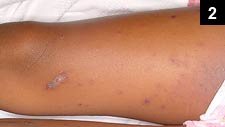
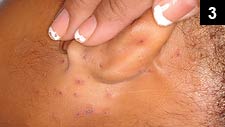
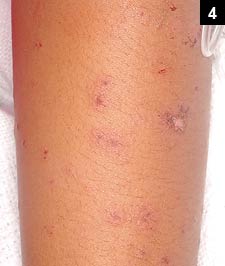

Examination revealed normal vital signs, with the only positive findings being a 4 cm × 4 cm firm mass in the right inguinal area that had minimal pain on firm palpation and a rash that had a scaly appearance (figure 1). A widely scattered, discrete hyperpigmented papular and macular lesions were also noted. Some of these also had some dark-appearing centers (figures 2-4). The patient’s lips were inflamed with some bleeding, as seen in figure 5. Lastly, her palms and soles had numerous discrete macular lesions that were thought initially to be petechiae (figures 6-7). All lesions appeared to “fixed” (unchanging).
Lab tests performed on admission included a complete blood count, erythrocyte sedimentation rate, complete metabolic profile, coagulation studies and urine analysis, all of which were normal. Pending tests include cultures of blood and urine, Rickettsial titers and a skin lesion biopsy.

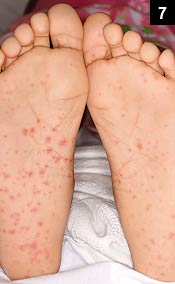
What’s your diagnosis?
- Erythema multiforme
- Mucocutaneous lymph node syndrome (Kawasaki disease)
- Rocky Mountain spotted fever
- Stevens-Johnson syndrome
Answer
The lesions on the palms and soles caused some confusion until it was clear that they were not petechiae, but rather macular lesions that, along with the rest of the picture — that is, “fixed,” annular target-like lesions with some central necrosis — were consistent with erythema multiforme.
This is often confused with annular, giant urticaria but usually easy to clarify, as urticaria has transient lesions without central necrosis but rather pale or dusky centers (figure 8). The fixed lesions of erythema multiforme will persist for days to over a week. The diagnosis was confirmed by the skin biopsy, revealing “central necrosis surrounded by a rim of perivenular inflammation or vacuolar interface dermatitis,” with the interpretation being consistent with erythema multiforme.
Although it is uncommon, aspirin can trigger erythema multiforme (which was the dermatologist’s best guess), as could the ingredients in the decongestant. More likely, however, the virus causing the febrile illness with congestion, or whatever was causing the swelling of the right inguinal node, was responsible. It could also be that the node was an unrelated finding in that it never enlarged further and resolved without complications.
The actual cause in this case will remain a mystery; however, erythema multiforme is known to be triggered by a wide range of infectious agents, including mycoplasma and, most commonly, herpes simplex virus infections. Because of the appearance of the patient’s lips, a couple of suspicious lesions were tested by culture and polymerase chain reaction for herpes simplex, but they were negative.
Some would call this condition erythema multiforme minor (with only one mucous membrane surface being inflamed) as opposed to erythema multiforme major (those with at least two mucous membranes involved), which many experts consider the same as Stevens-Johnson syndrome.
There was initial concern for possible Rocky Mountain spotted fever — so much so that the patient was empirically treated with doxycycline for seven days. However, in looking back, Rocky Mountain spotted fever would be unusual to present in the fashion that this child did.
Patients with Rocky Mountain spotted fever typically have fever, which this child did not have around the time of admission. Also, these patients almost always complain of headache, along with other systemic complaints, such as generalized aches and pains, nausea, vomiting, diarrhea and abdominal pain. The rash is typically maculopapular with petechiae that starts on the distal extremities around the wrists and ankles and then rapidly spreads to the rest of the body (figure 9, courtesy of Jim Bass, MD).
In addition, patients with Rocky Mountain spotted fever often have thrombocytopenia, anemia and leukopenia and may have abnormal coagulation studies. With the exception of the rash on the palms and soles, none of these other findings were present in this patient. Moreover, Rocky Mountain spotted fever is unusual in central Texas (Temple) but not unheard of, especially with the high mobility of our population.
It is not unusual for patients with erythema multiforme and Stevens-Johnson syndrome to have palmar and plantar involvement of the rash, making it easy to include Rocky Mountain spotted fever in the differential. However, the serology for Rickettsial antibodies was negative, and the skin biopsy confirmed erythema multiforme. Having said all this, one should not wait to confirm the diagnosis of Rocky Mountain spotted fever to initiate therapy, as a delay in treatment can result in worsening disease, with increased morbidity and mortality.
Kawasaki disease has several features in common with the patient presented. The rash could be the same, as could the enlarged lymph node, although it is usually in the cervical area. The involvement of the hands and feet and inflammation of the lips are also possible; however, the patient’s fever was not remarkable, and the lack of inflammation of her eyes and lack of supportive lab tests (elevated erythrocyte sedimentation rate and thrombocytosis) make this diagnosis unlikely.
Lastly, the treatment of erythema multiforme is purely symptomatic and can be done with antihistamines and topical therapy with wet compresses. These patients often end up being treated with steroids; however, there are no evidence-based studies that show benefit. Please let me know if you know of a good scientific study to the contrary. It should be a prospective, double blind, placebo-controlled study with enough patients enrolled to reach statistical significance. Please do not send case reports and small and/or uncontrolled studies.
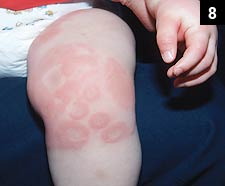
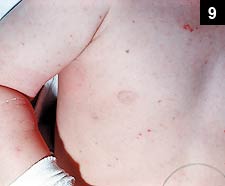
Commentary
Last month I stated that I was not the “brightest penny in the bank;” true to form, I proved it by apparently breaching the election rules of the AAP when I discussed training at Fitzsimons Army Medical Center in Denver under Jim Shira, one of the candidates for president-elect of the AAP, thereby endorsing and encouraging his candidacy.
Because this column is seen by many pediatricians whom I have never met, and therefore do not personally know, my commentary went against the election rules of the AAP (which I still have never actually seen). This lack of policy knowledge probably reflects my relative lack of direct involvement in the political process of the Academy. The most involvement I ever had was as a member of the Uniformed Services Section Executive Committee back in the 1980s. Having said that, I do learn about the candidates and vote each year, which is what I was trying to encourage with my commentary last month.
In an attempt to be fair, I am publishing the biography (below), provided by the AAP, of David T. Tayloe Jr., MD, FAAP, of Goldsboro, N.C. (Figure 10), the excellent candidate running against Dr. Shira.

David T. Tayloe Jr., MD, FAAP; Goldsboro, N.C.
Dave Tayloe Jr. is in full-time general pediatric practice. He founded a solo practice in Goldsboro, N.C., in 1977 after completing medical school at the University of North Carolina and pediatric residencies at St. Christopher’s Hospital for Children and NC Memorial Hospital. The practice has grown to include 12 pediatricians, seven mid-level providers, a psychologist and two certified lactation consultants who provide comprehensive child health services in four offices coordinated by an electronic health records system.
Dr. Tayloe has extensive experience in his community as a visionary leader in efforts to address school health issues, child abuse prevention and adolescent pregnancy prevention.
Dave has served in the leadership of the NC Chapter since 1985. When he was president (1993-1995), North Carolina won the Outstanding Chapter Award of the AAP.
Dr. Tayloe has been one of the architects of the successful child health system in North Carolina that includes the NC Universal Childhood Vaccine Distribution Program, the physician-directed Medicaid managed care initiative and the NC Health Choice Program (SCHIP).
Dave has served in a leadership position with the national AAP since 1989: Committee on State Government Affairs, Chapter Forum Committee (chairperson, 1999), Committee on Community Health Services, District IV vice-chairperson and district chairperson. He is the Board Liaison to the Task Force on Immunizations.
As a member of the Long-range Planning Committee of the American Board of Pediatrics (ABP), he has led the effort to incorporate mental health competencies into the agenda of the ABP.
Final comments
As I mentioned last month, please learn about both candidates and vote. We are fortunate to have such selfless, highly qualified pediatricians to give of themselves to the advancement of the AAP, which directly benefits children.
Lastly, there are several guest columnists with excellent cases waiting in the wings. They will begin appearing in the August issue with an interesting surgical case by a Texas A&M medical student. Also, because of the length of this month’s commentary, I will delay my report on our recent medical education trip to Iraq until next month. In the meantime, children burn fast; watch out for the sun!
